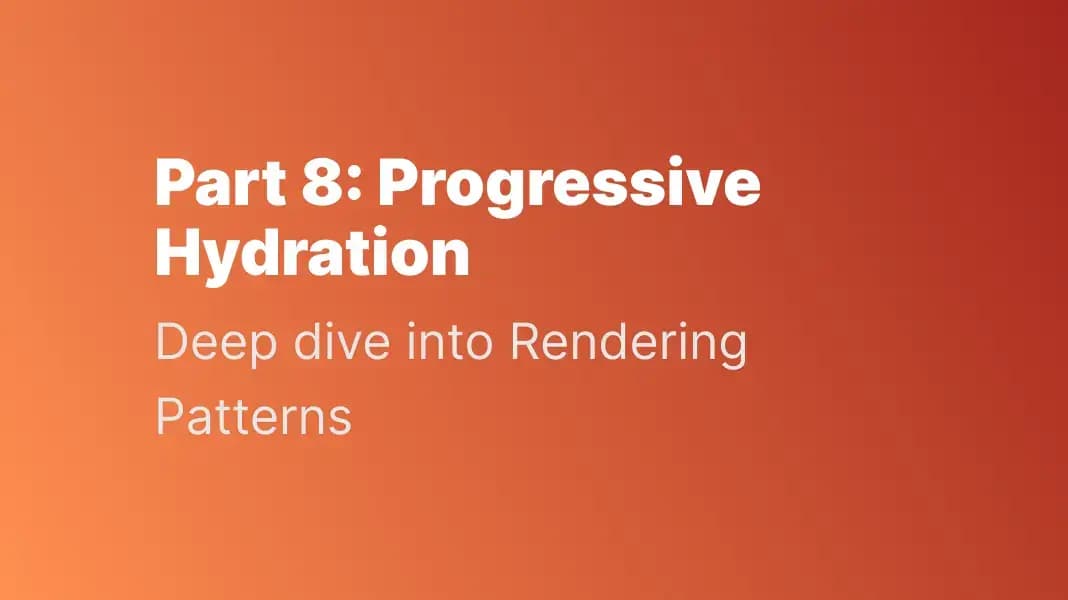user
Hey Chat, could you explain Progressive Hydration in simple terms, assuming I have no idea about rendering patterns? 🤔

Your Name
June 26, 2024
5 min read

Welcome back! In our previous post, we discussed Incremental Site Generation. Today, we'll explore Progressive Hydration, an advanced technique that optimizes the process of making a server-rendered page interactive. Instead of hydrating the entire page at once, Progressive Hydration gradually hydrates portions of the page as needed, enhancing performance and user experience.
Web Development Group
Me , Server , Browser, CDN, Narrator
user
Hey Chat, could you explain Progressive Hydration in simple terms, assuming I have no idea about rendering patterns? 🤔
narrator
Imagine an artist creating a massive mural. Instead of painting it all at once, it's time consuming process that would make viewers wait, they strategically begin with the sections that will immediately catch the viewer's eye. As people walk along the mural, the artist progressively adds more color and detail, guiding the viewer's gaze and unfolding the artwork's story piece by piece.
narrator
Progressive hydration works similarly: initially, only the visible parts of the web page are fully painted (hydrated). As the user scrolls or interacts with the page, additional sections are progressively hydrated, ensuring a seamless and efficient experience.
user
Mmm, that sounds interesting! Could you explain a real world example, showing the step by step process of how the server and browser work together to make this happen? 🤔
server
Okay, let me explain! My role as the server is to take your application's components and turn them into a complete HTML document. Then, I send that document to the browser so it can start making the page interactive.
browser
browser
user
So, Progressive Hydration aims to optimize the Time to Interactive (TTI)? ⏱️
server
Exactly! By loading only essential JavaScript first and the rest progressively, the page becomes usable faster, which improves the TTI and overall user experience. 🚀
user
So, what are the main advantages of using Progressive Hydration?
server
User Experience: Interactivity is added progressively, improving the Time to Interactive metric 🎨
server
SEO: Like SSG, the static content is easily crawlable by search engines, improving SEO. 📈
server
Flexibility: Allows developers to prioritize which parts of the page should become interactive . 🔄
user
Are there any challenges or downsides to using Progressive Hydration?
server
Limitations: Not suitable for highly dynamic apps where all elements need to be interactive are in the viewport, such as chat applications.
server
Complexity: Implementing Progressive Hydration can be more complex compared to traditional Hydration. It requires careful planning of when and how to hydrate parts of the page. 🧩
server
JavaScript Management: Ensuring efficient loading and execution of JavaScript can be challenging. Overloading the page with too much JavaScript can negate the performance benefits. 🚧
server
Duplicate Execution: The same app logic might need to run twice – first on the server to generate the initial HTML, and then again in the browser during hydration to add interactivity.
user
How can I start implementing Progressive Hydration in my projects?
server
Here are some steps to get you started:
server
server
server
user
Thanks, Chat! This was really insightful. Any final thoughts? 😊
server
You're welcome! 😊 Progressive Hydration is a powerful technique that balances performance and user experience. By delivering static content first and progressively adding interactivity, you can create fast, engaging, and SEO-friendly websites. Don't forget to experiment and test thoroughly to get the best results. Stay tuned for our next conversation where we'll dive into Edge Rendering for even faster content delivery! 🌐
user
Looking forward to it! 📚
me
Thanks for taking the time to read my article! I'd love to hear your feedback – any questions, suggestions, or different perspectives are welcome. Your input helps me improve and create even better content. Feel free to follow me and continue the conversation on 𝕏 to continue the discussion.
We hope you found our discussion on Progressive Hydration insightful. Join us next time as we dive into Streaming Server-Side Rendering, a technique that delivers content to users more efficiently by streaming the HTML from the server. Goodbye for now, and see you in our next post on Streaming Server-Side Rendering!
Experienced Frontend Developer | Passionate about building elegant, accessible, and UX-friendly Design Systems with React | Skilled in React Next Remix | CSS enthusiast | Lover of Clean & Maintainable CSS | Always learning and growing.
Let's ConnectConnect With Me On Social Media
I appreciate your visit to my website. If you find my work interesting and would like to know more about me, please consider following me on social media. Thank you!
© 2025 Hamza Miloud Amar. All Rights Reserved
1380 Views